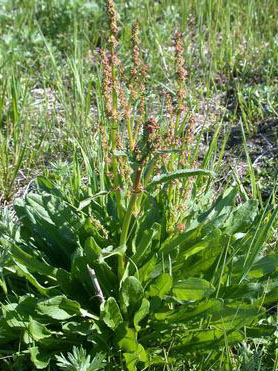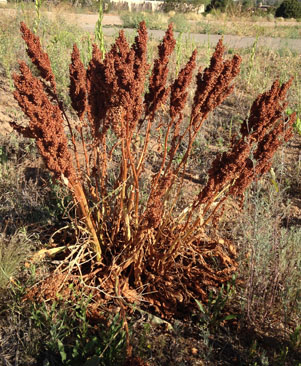 |
 |
Food:
"All docks are said to be edible, and curled dock is considered on of the best. Even young leaves may be considered too sour to be eaten raw, but these plants remain tender through most of the growing season, and they can provide an excellent cooked vegetable (likened to beet greens). Sometimes they require 1-2 changes of water, depending on how bitter the are. Docks often produce large quantities of fruit, which can be stripped from the plant and then winnowed (with much effort) to separate the outer hulls. These seeds have been boiled into mush or ground into flour or meal for addition to breads, muffins and gravies. Some tribes leached dock seeds in cold water before using them for food." (Kershaw 210)
"The leaves, brimming with vitamins A and C, may be treated like spinach, boiled and served as a table green with seasoning, or eaten raw in salads, although the high oxalic acid content of some docks makes them rather tart. This tartness probably is why a few Puebloans still like to toast the green leaves and save them for winter to mix with beans. Young stems are usually prepared much like rhubarb, and some pueblos used to favor a jam made by boiling down the stems. Other groups of Indians have ground up the seeds into meal for mush and breads, but this practice hasn't been reported from local pueblos." (Dunmire and Tierney 170)
Recipe 1: Dock Leaf Nachos
"Start with a stack of 6 fresh organic corn tortillas. Heat 2 tablespoons canola oil in a large skillet to medium-high heat. Cook tortillas in pan until they just begin to harden, one side then the next. Remove tortillas from pan and break into several small pieces. Place chips into a glass pie dish.
Preheat oven to broil.
Evenly spread 1 cup black or pinto beans across the top of the chips. Add 1 cup finely chopped young dock leaves and 3 tablespoons chopped onion. Add 1/2 cup chopped green pepper and 1 cup cheddar or mozzarella cheese or cheese substitute. Top with chopped jalapeno (optional).
Place in oven on second to highest rack in center of broiler coil. Rotate after 2 minutes. Cook until cheese is bubbling and just begins to brown. Remove from oven and serve as is or with fresh salsa.
Variation: Use pre-made corn chips. Boil dock leaves first for 7 minutes; drain and add to nachos as described above." (Morgan 70)
Recipe 2: Stuffed Zucchini with Dock
"Summer is almost synonymous with creative zucchini recipes Here's one of my favorites, and it is amenable to endless variation. This looks like a long, complicated recipe but is actually easy. Basically you just need to precook the zucchini canoes, sauteing some veggies and shrimp in the meantime. Combine them, add cheese, and bake.
First cook 1 cup brown rice. Leftover rice works great too.
Preheat oven to 350 degrees F. Slice 2 large zucchinis in half, and scoop out the seeds; retain the pulp. This leaves canoe-shaped zucchini halves. Lightly coat the bottom of a glass baking dish with olive or coconut oil. Use a dish big enough to fit the 4 zucchini canoes. Place canoes in baking ish skin side down, and bake for 30 - 40 minutes.
Take 1/2 cup young dock leaves and 1/2 cup young flower stalks. Wash and pat dry. Chop leaves and chop flower stalks into very small pieces, as small as possible. Set aside.
Chop the following into very small pieces and keep in separate piles on cutting board: retain zucchini pulp, 1/4 cup green onions (OK to use chives or onion instead,2 carrots, and 8 shrimp.
While zucchini is baking, in a large skillet heat 1 tablespoon olive oil to medium-high heat. Add the green onions; saute for 4 minutes. Add the carrots; saute 4 more minutes. Add the shrimp, toss to combine, and cook 4 more minutes. Add the rest of the veggies, 1 cup cooked rice, an a splash of Bragg Liquid Aminos. Add 1/4 teaspoon crushed hot peppers. Saute for about 8 minutes over medium heat, stirring to prevent sticking. Remove from heat and place in a bowl to cool. Once mixture is cooled, add 1 egg and mix well.
When zucchini canoes are done, remove from oven. Fill to heaping with the rice and dock mixture. Top with grated cheese or cheese substitute. Sprinkle on some paprika. Bake for 15 to 20 minutes, or until cheese is melted and just begins to bubble and brown." (Morgan 71)
Medicine:
"Docks were often used interchangeably as medicines, but curled dock was one of the most widely recognized and used. The leaves are rich in protein, calcium, iron, potassium and vitamins. Curled dock can contain more vitamin C than oranges and more vitamin A (betacarotiene) than carrots. Dried, powdered leaves were sometimes used as dusting powder, added to salves or applied as a paste for healing sores and reducing itching. Dock leaves were rubbed on nettle stings to relieve the burning. They were also used to make gargles for treating mouth sores. ---The root tea has been used to treat jaundice and post-hepatitis flare-ups. Some people believe that the tea helps the body to eliminate heavy metals such as lead and arsenic. Dock plants contain anthraquinones, which have laxative and anti-bacterial effects and also stopthe growth of ringworm and other fungi." (Kershaw 210-11)
"The Acoma, Laguna, and Zuni seem to have discovered this connection (that they inhibit bacterial growth), for in times past they applied powdered roots to burns, sores, rashes and skin infections." (Dunmire and Tierney 170)
"Its leaves, considered excellent as 'greens', are mashed, mixed with salt and bound on the forehead for headache, and the roots are chewed to counter pyorrhea. (Curtin 97)
"Its primary uses are for treating constipation, blood disorders, skin diseases, rheumatism, and indigestion. For liver congestion and poor digestion of fatty foods, particularly meat and dairy products. A teaspoon of the chopped root, boiled in water, should be drunk morning and afternoon. For jaundice and post-hepatitis flare-ups, a tablespoon is boiled in water and sipped on during the day for three or four days. These quantities also have a mild but effective laxative function, and a rounded teaspoon in tea drunk before retiring for a specific constipation, although not for extended use, since, as in most plant laxatives, this an result in a laxative dependence. An old remedy for skin eruptions due to internal toxicity or nervousness, one-half teaspoon tea should be consumed at least three times a day for several days or a week. Yellow Dock is even more effective, especially when the eruptions are on oily skin of the neck and back, if combined with Burdock, sarsparilla, and/or echinacea. ---Yellow Dock root will aid in reducing bleeding piles or inflamed diverticula of the colon and rectum. The root has some keratolytic activity, and is therefore useful externally for suppurating ulcers skin infections, and poorly healed abrasions. (Moore 166)
Other Uses:
"Wild rhubarb was among the several plants with high tannin content used at various pueblos in tanning rawhide. The Hopi have a tradition of using this species mixed with other plants to manufacture yellow dyes, but no dye use for dock has been recorded among the Puebloans of New Mexico." (Dunmire and Tierney 170)